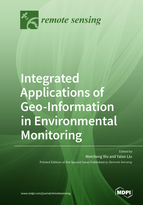Integrated Applications of Geo-Information in Environmental Monitoring
A special issue of Remote Sensing (ISSN 2072-4292).
Deadline for manuscript submissions: closed (31 December 2021) | Viewed by 51551
Special Issue Editors
Interests: environmental remote sensing; land resource mapping; land degradation; multi-biome biomass; natural hazard risk zoning and machine learning
Special Issues, Collections and Topics in MDPI journals
Interests: intelligent remote sensing information extraction for natural resource and environment, including land cover/land use change, disaster monitoring and assessment, and key technologies of space information integration
Special Issues, Collections and Topics in MDPI journals
Special Issue Information
Dear Colleagues,
Geo-information technology, including remote sensing, GIS, has been playing a more and more important role in environmental monitoring, land resource quantification and mapping, natural hazard damage and risk assessment, urbanization and other land use change monitoring and modeling. New advancements and innovations have been achieved especially with the emergence of big data mining and machine learning including deep learning techniques. It is hence the objective of this Special Issue to provide a platform for worldwide experts in these fields to present and share their new research approaches and outcomes to promote the advancement of geo-information technology. This Special Issue will cover the following topics:
- Remote sensing-based machine learning and big data mining technique
- Land resource mapping and land cover change tracking
- Natural hazard damage assessment and risk zoning
- Land degradation and dust storm assessment
- Coastal environmental problem analysis
- Deformation monitoring and early warning by radar, InSAR and GPS
Prof. Dr. Weicheng Wu
Prof. Dr. Yalan Liu
Guest Editors
Manuscript Submission Information
Manuscripts should be submitted online at www.mdpi.com by registering and logging in to this website. Once you are registered, click here to go to the submission form. Manuscripts can be submitted until the deadline. All submissions that pass pre-check are peer-reviewed. Accepted papers will be published continuously in the journal (as soon as accepted) and will be listed together on the special issue website. Research articles, review articles as well as short communications are invited. For planned papers, a title and short abstract (about 100 words) can be sent to the Editorial Office for announcement on this website.
Submitted manuscripts should not have been published previously, nor be under consideration for publication elsewhere (except conference proceedings papers). All manuscripts are thoroughly refereed through a single-blind peer-review process. A guide for authors and other relevant information for submission of manuscripts is available on the Instructions for Authors page. Remote Sensing is an international peer-reviewed open access semimonthly journal published by MDPI.
Please visit the Instructions for Authors page before submitting a manuscript. The Article Processing Charge (APC) for publication in this open access journal is 2700 CHF (Swiss Francs). Submitted papers should be well formatted and use good English. Authors may use MDPI's English editing service prior to publication or during author revisions.
Keywords
- Remote Sensing
- Geo-information
- Big Data mining
- Machine learning
- Land resource mapping
- Hazard damage and risk
- Land degradation
- Dust storm







